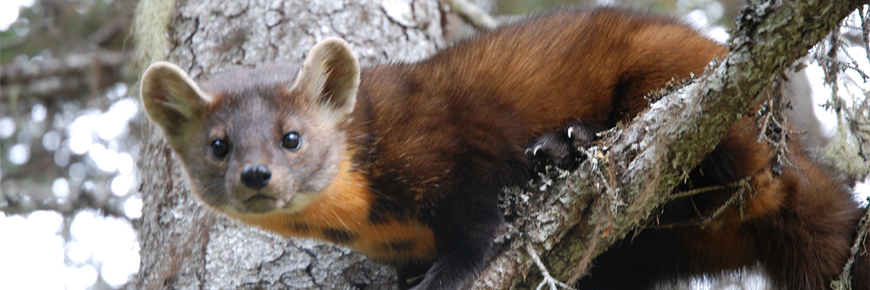
Newfoundland marten
Terra Nova National Park
Scientific Name: Martes Americana atrata
Conservation Status: Threatened
Background:
American Marten on the island of Newfoundland are a unique sub-species. The marten is a member of the weasel family and can be distinguished by an orange throat patch and dark brown fur.
The American Marten is a mature forest animal which prefers conifer forests with a high degree of canopy closure. It tends to live and rest in dens, burrows, holes, crevices and hollowed trees. As an omnivore, it feeds on such species as squirrels, hares, shrews, birds, insects, fish and berries.
In the mid-1980s, there were thought to be between 630 and 875 American Marten on the island of Newfoundland. A decade later, that estimate dropped to about 300.
Reasons for species loss
There are many reasons why this species of marten are now in such peril:
- Many are accidentally snared or trapped
- Habitat loss from commercial forest harvesting
- There is a high competition for a limited food supply
- They have many predators such as fox, owls, hawks, lynx, coyote and eagles
- They are susceptible to diseases such as rabies and canine distemper virus

Recovery strategies
Marten in Newfoundland were declared an endangered species in 1996 by the National Committee for the Status of Endangered Wildlife in Canada (COSEWIC). The species has now been downgraded to a threatened species. In Terra Nova National Park, we work to recover this unique species.
In 1998, Terra Nova National Park started a marten re-introduction program, in which we re-introduced animals from the Little Grand Lake area and Salmonier Nature Park. We continue to monitor the health of the population today by live-trapping and collecting biophysical information such as age, sex, hair samples (DNA), weight and dental health.
Past work by the provincial Marten Recovery Team has determined ways to prevent accidental marten mortality. Floating mink traps that are set in water are now available and are less likely to attract marten. The use of 22 gauge brass or 6-strand picture cord snare wire is now the only legal way to set a rabbit snare in the province. Marten can break this type of wire as they roll to try and escape.
How are they doing?
Today, the American Marten population in Newfoundland is believed to be somewhere between 286 to 556 adults across the island. In the park, marten are doing well and animals are beginning to disperse to areas outside the park. The population is still at risk because of snaring and trapping outside of protected areas, however, improvements to snaring regulations and management of large intact landscapes for the conservation of biodiversity may result in increases over time. Public awareness continues to be a key factor in reducing accidental mortality.

Related links
- Date modified :